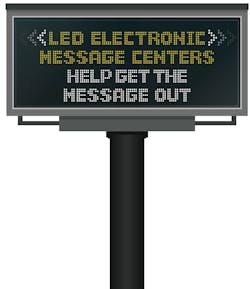Consumers are increasingly bombarded with messages. From emails and texts on their handsets, to a plethora of billboards on the road, it is hard to escape them. For oil and lube operators, the days of plastic letters on a marquee simply won’t cut it anymore. Announcing a special or service on a static sign might not be enough to draw in the passerby — especially as many consumers simply tune out what they’ve already seen.
To stay ahead of the curve and ensure messages connect with the customer involves something with a little flair. This is where an LED electronic message center might help make the connection. LED signs can be banners or digital reader boards equipped with light emitting diodes to display editable messages.
LED signs are becoming increasingly common and are helping transform Main Street operations into something with a little Times Square pizzazz. LED signs are now available in monochrome or grayscale, which provide 256 shades of the same color, or in full-color with full motion video and graphics. Unlike other lit signs, LED signs are durable, use less power, last for years and are editable by the user.
“Today’s LED electronic message centers (EMCs) have a higher resolution than what was available a few years ago,” said John Kunze, director of Watchfire, a manufacturer of LED signs. “Retailers are getting more for the money. Today, you can show everything from large text to a video of a technician performing an oil change in full resolution color.”
Because of the brightness of this technology, a one-inch character on an LED message center can be visible for up to 30-50 feet. The same character on a vinyl sign may only be readable at 10 feet. A nine-inch character could be visible and readable at 450 feet, while a 12-inch character could be seen as far away as 600 feet during the day and potentially further at night.
LED signs can last up to 100,000 hours, which is more than 11 years of continuous illumination, 24 hours a day; and at the same time they only use a fraction of the energy of an incandescent bulb. Because these signs can be on for long periods of time, users should take advantage of the ability to edit and refresh the message.
“The signs have been proven to increase sales for businesses, but the message really has to change to be effective,” said Nancy Maren, executive director of the United States Sign Council (USSC). “If you aren’t changing the message why have a changeable message sign? The purpose is to change the message.”
The effectiveness of LED EMCs can be debated, but when used effectively they can help draw in customers.
“For people who sell products or services, these signs can help increase business,” Maren added. “This is because you can change the message easily. Static signs are seen all the time, and people get used to them. The LED EMC provides a new message consumers notice.”
Mixed Messages
An LED EMC not only changes the message change, but it can also address different aspects of a business. This can be very important for oil and lube operators who offer other services, such as carwashes. Instead of having to decide which part of the business could benefit from a sign, an LED message center can tackle both and more.
“We use it for our oil change, but also for the carwash,” said Matt Evans of Walt’s In Out 10 Minute Oil Change in Willmar, Minnesota. “We offer double point Tuesdays and Free Coffee Fridays. In addition to mentioning our oil change service, we can highlight these other things [on our sign].”
Keith Ballentine of Citgo Express Lube in Rocky Mount, North Carolina, shares the opinion that one sign can do double duty.
“We use the sign a lot and share it with the convenience store we operate,” Ballentine explained. “It has both messages for the store as well as what we are doing with the oil change shop.”
People notice these signs Ballentine added.
“At first we were getting people who actually mentioned seeing the sign when we put it up a year-and-a-half ago,” Ballentine said. “We think putting up different messages has helped increase our business. I do feel anytime you can speak to the drive-by public it is in your favor more than it is not. This is really a good opportunity for grabbing that person who is driving by’s attention.”
One downside for operators such as Walt’s In Out 10 Minute Oil Change is that its sign is hardly the only one in town. While the drag doesn’t actually light up like Times Square, there are a number of businesses with similar signs.
“Everybody and their brother has gotten one of these signs,” Evans added. “There has been a huge increase in the last two or three years, and it seems every business has one now.”
This only necessitates the need to rotate the message.
“We’ve found the key is to rotate what is on the sign or people are going to start looking at the other signs,” Evans noted. “If the customer sees the same thing day after day, they might just keep driving by. We bought an LED sign because it can be updated so easily.”
Zoning Concerns
There are concerns that are keeping some oil and lube operators from opting for an LED sign. While cost and complexity are often cited by operators, another reason is local zoning may actually prohibit their use.
“If these signs came down in price I think I’d be interested,” said Donald Britain of Master Lube in Waco, Texas. “But that’s a moot point because the town won’t let me have a sign that flashes or moves back and forth. They’ll allow LED lights, but not ones that flash, so the more complex system is something we can’t use.”
David Beaty of Oil Stop in Santa Fe, New Mexico, was also told by his local city council an LED EMC was OK but not one that flashes.
“We were told such signs would distract drivers,” Beaty noted. “The city has told us we can’t have a moving LED sign, so we have it in the shop instead, where it doesn’t have the same impact.”
Because of advances in the technology, many EMCs can be adjusted to meet local concerns.
“We don’t believe there is any truth the signs will distract drivers,” Kunze said. “One study we found is that accidents went down because drivers may slow down to read some of the signs. In addition, there is code-friendly software to meet the code in any location.”
Other operators have considered the signs but felt they aren’t right for their particular neck of the woods. The manager at Hampton Oil Changer of Southampton, New York, would only say that the LED signs were a little “too gaudy” for the Hamptons, and it wasn’t something the customers would want to see.
“We do hear the fears over aesthetic, and we know some towns don’t want to look like Las Vegas,” Kunze admitted. “All the ads can be created tastefully. Instead of flash and video there can be a PowerPoint type of display that can be tastefully done and still help drive in business. Those businesses on Main Street can reap the positive impact from having an LED electronic sign.”
The concerns over cost, however, are something Maren said is being addressed.
“As with any new technology, the cost comes down and the quality increases,” Maren said. “The quality of today’s LED EMC is already very good, plus LED is cheaper than other lighting technology and LED lasts a really long time. It sends a message that can change and hopefully can’t be missed!”
About the Author

Peter Suciu
Peter Suciu is Michigan-based writer and NOLN freelance contributor who has contributed to more than four dozen magazines, newspapers and websites. He lives in the land of cars not far from one of Henry Ford's estates.
